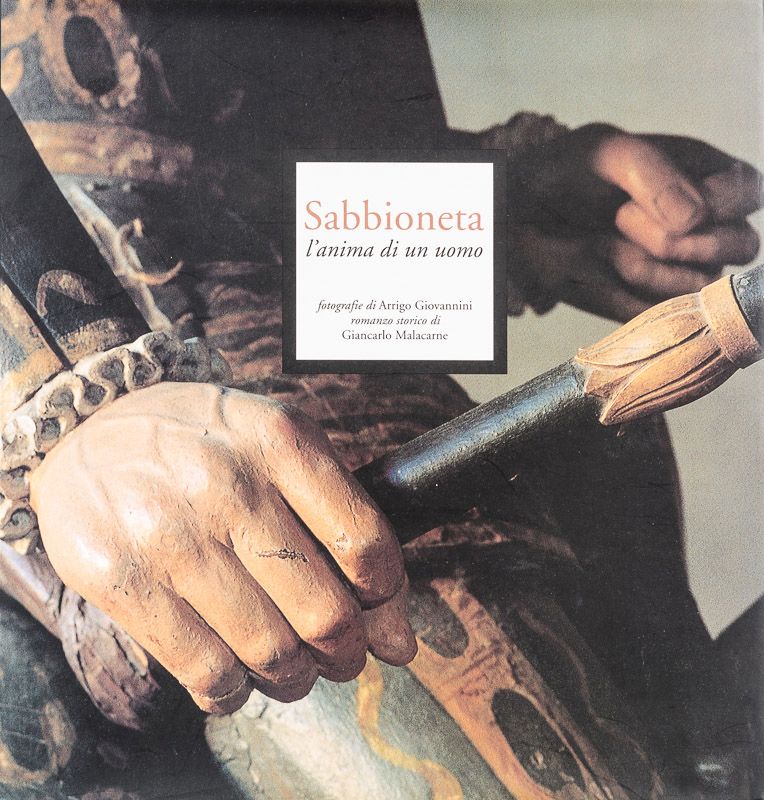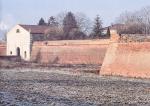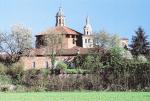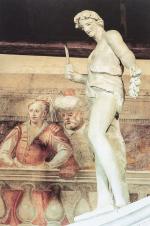Giovannini, Sabbioneta: L'anima di un uomo.
Sabbioneta: L’anima di un uomo. / The Soul of a Man [Bilingual edition in italian and english]. Fotografie di Arrigo Giovannini, romanzo storico di Gaincarlo Malacarne.
Verona, Promoprint, 1994. 28.7 cm x 28.7cm. 151 pages. Original Hardcover with original dustjacket. Very good condition with only minor signs of external wear.
Vespasiano I Gonzaga (6 December 1531 – 26 February 1591) was an Italian nobleman, diplomat, writer, military engineer and condottiero. He is remembered as a patron of the arts and the founder of Sabbioneta, a town in Lombardy designed according to the Renaissance principles of the “ideal city”.
He was born in Fondi, a Colonna fief in the southern Latium, the son of Isabella Colonna and the condottiero Luigi Gonzaga, lord of Palazzolo, a member of a cadet branch of the House of Gonzaga, Dukes of Mantua. Soon orphaned, he was educated under his aunt Giulia Gonzaga, who had moved to Naples to escape attempts from other members of the Colonna family to kill Vespasiano in order to obtain the fiefs he had inherited from his mother.
The Ducal Palace of Sabbioneta.
At the age of eleven he was sent to the Spanish royal court to complete his education under his uncle, King Philip II of Spain. The latter found in Vespasiano one of his most faithful advisors, and made him a Grandee of Spain and then Viceroy of Navarre and Valencia. In 1556 he started his major project, the construction of a new, ideal city between Mantua and Parma which he christened “Sabbioneta” (″Sandy”), as it was to rise on the sandy banks of the Po River. The project was finished in 1591. Sabbioneta had been declared an autonomous Duchy in 1577, thanks to the personal support of Vespasiano’s friend Rudolf II of Habsburg, whom he had met in the Spanish court. He died at Sabbioneta in 1591. (Wikipedia)
Sabbioneta is a town and comune in the province of Mantua, Lombardy region, Northern Italy. It is situated about 30 kilometres (19 mi) north of Parma, not far from the northern bank of the Po River. It was inscribed in the World Heritage List in 2008.
Sabbioneta was founded by Vespasiano I Gonzaga in the late 16th century along the ancient Roman Via Vitelliana, on a sandy bank of the Po (whence the name, meaning “Sandy” in Italian); he was its first duke, using it as a personal fortress and residence. It was also during this period that it became a minor musical centre; composers such as Benedetto Pallavicino were employed here by Vespasiano Gonzaga, prior to his moving to the main Gonzaga city of Mantua.In 2008, Sabbioneta was inscribed in the UNESCO World Heritage List as a recognition of its perfect example of practical application of Renaissance urban planning theories.
Sabbioneta is also known for its historic Jewish Ghetto and Synagogue, and in particular for its Hebrew printing-press. In 1551 Tobias Foa set up the press; he had, however, published certain “anti-Christian books” and his career was “forcibly ended”. His work and possibly his type were taken up by a Christian printer, Vicenzo Conte. Vespasiano Gonzaga’s town, designed according to the Renaissance principles of the Ideal City, included:
The Ducal Palace (now the Town Hall)
The Teatro all’antica (″Theatre in the style of the Ancients”), designed by Vincenzo Scamozzi
The Galleria degli Antichi and Palazzo del Giardino: “Gallery of the Ancient” and “Garden Palace” respectively.)
Churches of the Assunta, Incoronata and Carmine
The church and the summer palace contain frescoes by artists of the Campi family of Cremona. (Wikipedia)
- Keywords: Italia · Italian Architecture · Italian Art · Italian Culture · Italian History · Italian History – Rare · Lombardei · Lombardy · Travel
- Language: English
- Inventory Number: 42904AB
EUR 68,--
© 2025 Inanna Rare Books Ltd. | Powered by HESCOM-Software
















